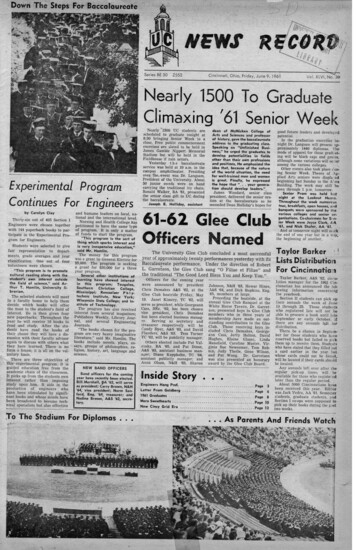
Transcription
End of Chapter SolutionsCorporate Finance 8th editionRoss, Westerfield, and JaffeUpdated 11-21-2006
CHAPTER 1INTRODUCTION TO CORPORATEFINANCEAnswers to Concept Questions1.In the corporate form of ownership, the shareholders are the owners of the firm. The shareholderselect the directors of the corporation, who in turn appoint the firm’s management. This separation ofownership from control in the corporate form of organization is what causes agency problems toexist. Management may act in its own or someone else’s best interests, rather than those of theshareholders. If such events occur, they may contradict the goal of maximizing the share price of theequity of the firm.2.Such organizations frequently pursue social or political missions, so many different goals areconceivable. One goal that is often cited is revenue minimization; i.e., provide whatever goods andservices are offered at the lowest possible cost to society. A better approach might be to observe thateven a not-for-profit business has equity. Thus, one answer is that the appropriate goal is tomaximize the value of the equity.3.Presumably, the current stock value reflects the risk, timing, and magnitude of all future cash flows,both short-term and long-term. If this is correct, then the statement is false.4.An argument can be made either way. At the one extreme, we could argue that in a market economy,all of these things are priced. There is thus an optimal level of, for example, ethical and/or illegalbehavior, and the framework of stock valuation explicitly includes these. At the other extreme, wecould argue that these are non-economic phenomena and are best handled through the politicalprocess. A classic (and highly relevant) thought question that illustrates this debate goes somethinglike this: “A firm has estimated that the cost of improving the safety of one of its products is 30million. However, the firm believes that improving the safety of the product will only save 20million in product liability claims. What should the firm do?”5.The goal will be the same, but the best course of action toward that goal may be different because ofdiffering social, political, and economic institutions.6.The goal of management should be to maximize the share price for the current shareholders. Ifmanagement believes that it can improve the profitability of the firm so that the share price willexceed 35, then they should fight the offer from the outside company. If management believes thatthis bidder or other unidentified bidders will actually pay more than 35 per share to acquire thecompany, then they should still fight the offer. However, if the current management cannot increasethe value of the firm beyond the bid price, and no other higher bids come in, then management is notacting in the interests of the shareholders by fighting the offer. Since current managers often losetheir jobs when the corporation is acquired, poorly monitored managers have an incentive to fightcorporate takeovers in situations such as this.
B-2SOLUTIONS7.We would expect agency problems to be less severe in other countries, primarily due to the relativelysmall percentage of individual ownership. Fewer individual owners should reduce the number ofdiverse opinions concerning corporate goals. The high percentage of institutional ownership mightlead to a higher degree of agreement between owners and managers on decisions concerning riskyprojects. In addition, institutions may be better able to implement effective monitoring mechanismson managers than can individual owners, based on the institutions’ deeper resources and experienceswith their own management.8.The increase in institutional ownership of stock in the United States and the growing activism ofthese large shareholder groups may lead to a reduction in agency problems for U.S. corporations anda more efficient market for corporate control. However, this may not always be the case. If themanagers of the mutual fund or pension plan are not concerned with the interests of the investors, theagency problem could potentially remain the same, or even increase since there is the possibility ofagency problems between the fund and its investors.9.How much is too much? Who is worth more, Jack Welch or Tiger Woods? The simplest answer isthat there is a market for executives just as there is for all types of labor. Executive compensation isthe price that clears the market. The same is true for athletes and performers. Having said that, oneaspect of executive compensation deserves comment. A primary reason executive compensation hasgrown so dramatically is that companies have increasingly moved to stock-based compensation.Such movement is obviously consistent with the attempt to better align stockholder and managementinterests. In recent years, stock prices have soared, so management has cleaned up. It is sometimesargued that much of this reward is simply due to rising stock prices in general, not managerialperformance. Perhaps in the future, executive compensation will be designed to reward onlydifferential performance, i.e., stock price increases in excess of general market increases.10. Maximizing the current share price is the same as maximizing the future share price at any futureperiod. The value of a share of stock depends on all of the future cash flows of company. Anotherway to look at this is that, barring large cash payments to shareholders, the expected price of thestock must be higher in the future than it is today. Who would buy a stock for 100 today when theshare price in one year is expected to be 80?
CHAPTER 2ACCOUNTING STATEMENTS, TAXES,AND CASH FLOWAnswers to Concepts Review and Critical Thinking Questions1.True. Every asset can be converted to cash at some price. However, when we are referring to a liquidasset, the added assumption that the asset can be converted cash at or near market value is important.2.The recognition and matching principles in financial accounting call for revenues, and the costsassociated with producing those revenues, to be “booked” when the revenue process is essentiallycomplete, not necessarily when the cash is collected or bills are paid. Note that this way is notnecessarily correct; it’s the way accountants have chosen to do it.3.The bottom line number shows the change in the cash balance on the balance sheet. As such, it is nota useful number for analyzing a company.4.The major difference is the treatment of interest expense. The accounting statement of cash flowstreats interest as an operating cash flow, while the financial cash flows treat interest as a financingcash flow. The logic of the accounting statement of cash flows is that since interest appears on theincome statement, which shows the operations for the period, it is an operating cash flow. In reality,interest is a financing expense, which results from the company’s choice of debt and equity. We willhave more to say about this in a later chapter. When comparing the two cash flow statements, thefinancial statement of cash flows is a more appropriate measure of the company’s performancebecause of its treatment of interest.5.Market values can never be negative. Imagine a share of stock selling for – 20. This would meanthat if you placed an order for 100 shares, you would get the stock along with a check for 2,000.How many shares do you want to buy? More generally, because of corporate and individualbankruptcy laws, net worth for a person or a corporation cannot be negative, implying that liabilitiescannot exceed assets in market value.6.For a successful company that is rapidly expanding, for example, capital outlays will be large,possibly leading to negative cash flow from assets. In general, what matters is whether the money isspent wisely, not whether cash flow from assets is positive or negative.7.It’s probably not a good sign for an established company to have negative cash flow from assets, butit would be fairly ordinary for a start-up, so it depends.
B-4SOLUTIONS8.For example, if a company were to become more efficient in inventory management, the amount ofinventory needed would decline. The same might be true if the company becomes better at collectingits receivables. In general, anything that leads to a decline in ending NWC relative to beginningwould have this effect. Negative net capital spending would mean more long-lived assets wereliquidated than purchased.9.If a company raises more money from selling stock than it pays in dividends in a particular period,its cash flow to stockholders will be negative. If a company borrows more than it pays in interest andprincipal, its cash flow to creditors will be negative.10. The adjustments discussed were purely accounting changes; they had no cash flow or market valueconsequences unless the new accounting information caused stockholders to revalue the derivatives.Solutions to Questions and ProblemsNOTE: All end-of-chapter problems were solved using a spreadsheet. Many problems require multiplesteps. Due to space and readability constraints, when these intermediate steps are included in thissolutions manual, rounding may appear to have occurred. However, the final answer for each problem isfound without rounding during any step in the problem.Basic1.To find owner’s equity, we must construct a balance sheet as follows:CANFATABalance SheetCLLTDOE 28,000TL & OE 5,00023,000 4,30013,000? 28,000We know that total liabilities and owner’s equity (TL & OE) must equal total assets of 28,000. Wealso know that TL & OE is equal to current liabilities plus long-term debt plus owner’s equity, soowner’s equity is:OE 28,000 –13,000 – 4,300 10,700NWC CA – CL 5,000 – 4,300 7002.The income statement for the company is:Income s (35%)Net income 527,000280,00038,000 209,00015,000 194,00067,900 126,100
CHAPTER 2 B-5One equation for net income is:Net income Dividends Addition to retained earningsRearranging, we get:Addition to retained earnings Net income – DividendsAddition to retained earnings 126,100 – 48,000Addition to retained earnings 78,1003.To find the book value of current assets, we use: NWC CA – CL. Rearranging to solve for currentassets, we get:CA NWC CL 900K 2.2M 3.1MThe market value of current assets and fixed assets is given, so:Book value CA 3.1MBook value NFA 4.0MBook value assets 3.1M 4.0M 7.1M4.Market value CA 2.8MMarket value NFA 3.2MMarket value assets 2.8M 3.2M 6.0MTaxes 0.15( 50K) 0.25( 25K) 0.34( 25K) 0.39( 273K – 100K)Taxes 89,720The average tax rate is the total tax paid divided by net income, so:Average tax rate 89,720 / 273,000Average tax rate 32.86%The marginal tax rate is the tax rate on the next 1 of earnings, so the marginal tax rate 39%.5.To calculate OCF, we first need the income statement:Income StatementSalesCostsDepreciationEBITInterestTaxable incomeTaxes (35%)Net income 13,5005,4001,200 6,900680 6,2202,177 4,043OCF EBIT Depreciation – TaxesOCF 6,900 1,200 – 2,177OCF 5,9236.Net capital spending NFAend – NFAbeg DepreciationNet capital spending 4,700,000 – 4,200,000 925,000Net capital spending 1,425,000
B-67.SOLUTIONSThe long-term debt account will increase by 8 million, the amount of the new long-term debt issue.Since the company sold 10 million new shares of stock with a 1 par value, the common stockaccount will increase by 10 million. The capital surplus account will increase by 16 million, thevalue of the new stock sold above its par value. Since the company had a net income of 7 million,and paid 4 million in dividends, the addition to retained earnings was 3 million, which willincrease the accumulated retained earnings account. So, the new long-term debt and stockholders’equity portion of the balance sheet will be:Long-term debtTotal long-term debt 68,000,000 68,000,000Shareholders equityPreferred stockCommon stock ( 1 par value)Accumulated retained earningsCapital surplusTotal equity 18,000,00035,000,00092,000,00065,000,000 210,000,000Total Liabilities & Equity 278,000,0008.Cash flow to creditors Interest paid – Net new borrowingCash flow to creditors 340,000 – (LTDend – LTDbeg)Cash flow to creditors 340,000 – ( 3,100,000 – 2,800,000)Cash flow to creditors 340,000 – 300,000Cash flow to creditors 40,0009.Cash flow to stockholders Dividends paid – Net new equityCash flow to stockholders 600,000 – [(Commonend APISend) – (Commonbeg APISbeg)]Cash flow to stockholders 600,000 – [( 855,000 7,600,000) – ( 820,000 6,800,000)]Cash flow to stockholders 600,000 – ( 8,455,000 – 7,620,000)Cash flow to stockholders – 235,000Note, APIS is the additional paid-in surplus.10. Cash flow from assets Cash flow to creditors Cash flow to stockholders 40,000 – 235,000 – 195,000Cash flow from assets– 195,000 – 195,000 OCF – Change in NWC – Net capital spending OCF – (– 165,000) – 760,000Operating cash flowOperating cash flow – 195,000 165,000 760,000 730,000
CHAPTER 2 B-7Intermediate11. a.The accounting statement of cash flows explains the change in cash during the year. Theaccounting statement of cash flows will be:Statement of cash flowsOperationsNet incomeDepreciationChanges in other current assets 12575(25)Total cash flow from operations 175Investing activitiesAcquisition of fixed assetsTotal cash flow from investing activities (175) (175)Financing activitiesProceeds of long-term debtCurrent liabilitiesDividendsTotal cash flow from financing activities 9010(65) 35Change in cash (on balance sheet) 35b.Change in NWC NWCend – NWCbeg (CAend – CLend) – (CAbeg – CLbeg) [( 45 145) – 70] – [( 10 120) – 60) 120 – 70 50c.To find the cash flow generated by the firm’s assets, we need the operating cash flow, and thecapital spending. So, calculating each of these, we find:Operating cash flowNet incomeDepreciationOperating cash flow 12575 200Note that we can calculate OCF in this manner since there are no taxes.
B-8SOLUTIONSCapital spendingEnding fixed assetsBeginning fixed assetsDepreciationCapital spending 250(150)75 175Now we can calculate the cash flow generated by the firm’s assets, which is:Cash flow from assetsOperating cash flowCapital spendingChange in NWCCash flow from assets 200(175)(50) (25)Notice that the accounting statement of cash flows shows a positive cash flow, but the financialcash flows show a negative cash flow. The cash flow generated by the firm’s assets is a betternumber for analyzing the firm’s performance.12. With the information provided, the cash flows from the firm are the capital spending and the changein net working capital, so:Cash flows from the firmCapital spendingAdditions to NWCCash flows from the firm (3,000)(1,000) (4,000)And the cash flows to the investors of the firm are:Cash flows to investors of the firmSale of short-term debtSale of long-term debtSale of common stockDividends paidCash flows to investors of the firm (7,000)(18,000)(2,000)23,000 (4,000)
CHAPTER 2 B-913. a.The interest expense for the company is the amount of debt times the interest rate on the debt.So, the income statement for the company is:Income StatementSalesCost of goods soldSelling costsDepreciationEBITInterestTaxable incomeTaxes (35%)Net incomeb. 1,000,000300,000200,000100,000 400,000100,000 300,000105,000 195,000And the operating cash flow is:OCF EBIT Depreciation – TaxesOCF 400,000 100,000 – 105,000OCF 395,00014. To find the OCF, we first calculate net income.Income StatementSales 145,000Costs86,000Depreciation7,000Other expenses4,900EBIT 47,100Interest15,000Taxable income 32,100Taxes (40%)12,840Net income 19,260DividendsAdditions to RE 8,700 10,560a.OCF EBIT Depreciation – TaxesOCF 47,100 7,000 – 12,840OCF 41,260b.CFC Interest – Net new LTDCFC 15,000 – (– 6,500)CFC 21,500Note that the net new long-term debt is negative because the company repaid part of its longterm debt.c.CFS Dividends – Net new equityCFS 8,700 – 6,450CFS 2,250
B-10 SOLUTIONSd.We know that CFA CFC CFS, so:CFA 21,500 2,250 23,750CFA is also equal to OCF – Net capital spending – Change in NWC. We already know OCF.Net capital spending is equal to:Net capital spending Increase in NFA DepreciationNet capital spending 5,000 7,000Net capital spending 12,000Now we can use:CFA OCF – Net capital spending – Change in NWC 23,750 41,260 – 12,000 – Change in NWC.Solving for the change in NWC gives 5,510, meaning the company increased its NWC by 5,510.15. The solution to this question works the income statement backwards. Starting at the bottom:Net income Dividends Addition to ret. earningsNet income 900 4,500Net income 5,400Now, looking at the income statement:EBT – (EBT Tax rate) Net incomeRecognize that EBT tax rate is simply the calculation for taxes. Solving this for EBT yields:EBT NI / (1– Tax rate)EBT 5,400 / 0.65EBT 8,308Now we can calculate:EBIT EBT InterestEBIT 8,308 1,600EBIT 9,908The last step is to use:EBIT Sales – Costs – Depreciation 9,908 29,000 – 13,000 – DepreciationDepreciation 6,092Solving for depreciation, we find that depreciation 6,092
CHAPTER 2 B-1116. The balance sheet for the company looks like this:CashAccounts receivableInventoryCurrent assetsTangible net fixed assetsIntangible net fixed assetsTotal assetsBalance Sheet 175,000Accounts payable140,000Notes payable265,000Current liabilities 580,000Long-term debtTotal liabilities2,900,000720,000Common stockAccumulated ret. earnings 4,200,000Total liab. & owners’ equity 430,000180,000 610,0001,430,000 2,040,000?1,240,000 4,200,000Total liabilities and owners’ equity is:TL & OE CL LTD Common stockSolving for this equation for equity gives us:Common stock 4,200,000 – 1,240,000 – 2,040,000Common stock 920,00017. The market value of shareholders’ equity cannot be zero. A negative market value in this case wouldimply that the company would pay you to own the stock. The market value of shareholders’ equitycan be stated as: Shareholders’ equity Max [(TA – TL), 0]. So, if TA is 4,300, equity is equal to 800, and if TA is 3,200, equity is equal to 0. We should note here that while the market value ofequity cannot be negative, the book value of shareholders’ equity can be negative.18. a.b.19.a.Taxes Growth 0.15( 50K) 0.25( 25K) 0.34( 10K) 17,150Taxes Income 0.15( 50K) 0.25( 25K) 0.34( 25K) 0.39( 235K) 0.34( 8.165M) 2,890,000Each firm has a marginal tax rate of 34% on the next 10,000 of taxable income, despite theirdifferent average tax rates, so both firms will pay an additional 3,400 in taxes.Income StatementSales 850,000COGS630,000A&S expenses120,000Depreciation130,000EBIT( 30,000)Interest85,000Taxable income( 115,000)Taxes (35%)0Net income( 115,000)
B-12 SOLUTIONSb.OCF EBIT Depreciation – TaxesOCF ( 30,000) 130,000 – 0OCF 100,000c. Net income was negative because of the tax deductibility of depreciation and interest expense.However, the actual cash flow from operations was positive because depreciation is a non-cashexpense and interest is a financing expense, not an operating expense.20. A firm can still pay out dividends if net income is negative; it just has to be sure there is sufficientcash flow to make the dividend payments.Change in NWC Net capital spending Net new equity 0. (Given)Cash flow from assets OCF – Change in NWC – Net capital spendingCash flow from assets 100,000 – 0 – 0 100,000Cash flow to stockholders Dividends – Net new equityCash flow to stockholders 30,000 – 0 30,000Cash flow to creditors Cash flow from assets – Cash flow to stockholdersCash flow to creditors 100,000 – 30,000Cash flow to creditors 70,000Cash flow to creditors is also:Cash flow to creditors Interest – Net new LTDSo:Net new LTD Interest – Cash flow to creditorsNet new LTD 85,000 – 70,000Net new LTD 15,00021. a.The income statement is:Income StatementSales 12,800Cost of good sold10,400Depreciation1,900EBIT 500Interest450Taxable income 50Taxes (34%)17Net income 33b.OCF EBIT Depreciation – TaxesOCF 500 1,900 – 17OCF 2,383
CHAPTER 2 B-13c. Change in NWC NWCend – NWCbeg (CAend – CLend) – (CAbeg – CLbeg) ( 3,850 – 2,100) – ( 3,200 – 1,800) 1,750 – 1,400 350Net capital spending NFAend – NFAbeg Depreciation 9,700 – 9,100 1,900 2,500CFA OCF – Change in NWC – Net capital spending 2,383 – 350 – 2,500 – 467The cash flow from assets can be positive or negative, since it represents whether the firm raisedfunds or distributed funds on a net basis. In this problem, even though net income and OCF arepositive, the firm invested heavily in both fixed assets and net working capital; it had to raise a net 467 in funds from its stockholders and creditors to make these investments.d.Cash flow to creditors Interest – Net new LTD 450 – 0 450Cash flow to stockholders Cash flow from assets – Cash flow to creditors – 467 – 450 – 917We can also calculate the cash flow to stockholders as:Cash flow to stockholders Dividends – Net new equitySolving for net new equity, we get:Net new equity 500 – (–917) 1,417The firm had positive earnings in an accounting sense (NI 0) and had positive cash flow fromoperations. The firm invested 350 in new net working capital and 2,500 in new fixed assets. Thefirm had to raise 467 from its stakeholders to support this new investment. It accomplished this byraising 1,417 in the form of new equity. After paying out 500 of this in the form of dividends toshareholders and 450 in the form of interest to creditors, 467 was left to meet the firm’s cashflow needs for investment.22. a.Total assets 2006 650 2,900 3,550Total liabilities 2006 265 1,500 1,765Owners’ equity 2006 3,550 – 1,765 1,785Total assets 2007 705 3,400 4,105Total liabilities 2007 290 1,720 2,010Owners’ equity 2007 4,105 – 2,010 2,095
B-14 SOLUTIONSb.NWC 2006NWC 2007Change in NWC CA06 – CL06 650 – 265 385 CA07 – CL07 705 – 290 415 NWC07 – NWC065 415 – 385 30c.We can calculate net capital spending as:Net capital spending Net fixed assets 2007 – Net fixed assets 2006 DepreciationNet capital spending 3,400 – 2,900 800Net capital spending 1,300So, the company had a net capital spending cash flow of 1,300. We also know that net capitalspending is:Net capital spending Fixed assets bought – Fixed assets sold 1,300 1,500 – Fixed assets soldFixed assets sold 1,500 – 1,300 200To calculate the cash flow from assets, we must first calculate the operating cash flow. Theoperating cash flow is calculated as follows (you can also prepare a traditional incomestatement):EBIT Sales – Costs – DepreciationEBIT 8,600 – 4,150 – 800EBIT 3,650EBT EBIT – InterestEBT 3,650 – 216EBT 3,434Taxes EBT u .35Taxes 3,434 u .35Taxes 1,202OCF EBIT Depreciation – TaxesOCF 3,650 800 – 1,202OCF 3,248Cash flow from assets OCF – Change in NWC – Net capital spending.Cash flow from assets 3,248 – 30 – 1,300Cash flow from assets 1,918d.Net new borrowing LTD07 – LTD06Net new borrowing 1,720 – 1,500Net new borrowing 220Cash flow to creditors Interest – Net new LTDCash flow to creditors 216 – 220Cash flow to creditors – 4Net new borrowing 220 Debt issued – Debt retiredDebt retired 300 – 220 80
CHAPTER 2 B-1523.CashAccounts receivableInventoryCurrent assetsNet fixed assetsTotal assetsCashAccounts receivableInventoryCurrent assetsNet fixed assetsTotal assetsBalance sheet as of Dec. 31, 2006 2,107Accounts payable2,789Notes payable4,959Current liabilities 9,855Long-term debtOwners' equity 17,669 27,524Total liab. & equityBalance sheet as of Dec. 31, 2007 2,155Accounts payable3,142Notes payable5,096Current liabilities 10,393Long-term debtOwners' equity 18,091 28,484Total liab. & equity 2,213407 2,620 7,056 17,848 27,524 2,146382 2,528 8,232 17,724 28,4842006 Income StatementSales 4,018.00COGS1,382.00Other expenses328.00Depreciation577.00EBIT 1,731.00Interest269.00EBT 1,462.00Taxes (34%)497.08Net income 964.922007 Income StatementSales 4,312.00COGS1,569.00Other expenses274.00Depreciation578.00EBIT 1,891.00Interest309.00EBT 1,582.00Taxes (34%)537.88Net income 1,044.12DividendsAdditions to REDividendsAdditions to RE 490.00 474.9224. OCF EBIT Depreciation – TaxesOCF 1,891 578 – 537.88OCF 1,931.12Change in NWC NWCend – NWCbeg (CA – CL) end – (CA – CL) begChange in NWC ( 10,393 – 2,528) – ( 9,855 – 2,620)Change in NWC 7,865 – 7,235 630Net capital spending NFAend – NFAbeg DepreciationNet capital spending 18,091 – 17,669 578Net capital spending 1,000 539.00 505.12
B-16 SOLUTIONSCash flow from assets OCF – Change in NWC – Net capital spendingCash flow from assets 1,931.12 – 630 – 1,000Cash flow from assets 301.12Cash flow to creditors Interest – Net new LTDNet new LTD LTDend – LTDbegCash flow to creditors 309 – ( 8,232 – 7,056)Cash flow to creditors – 867Net new equity Common stockend – Common stockbegCommon stock Retained earnings Total owners’ equityNet new equity (OE – RE) end – (OE – RE) begNet new equity OEend – OEbeg REbeg – REendREend REbeg Additions to RE? Net new equity OEend – OEbeg REbeg – (REbeg Additions to RE) OEend – OEbeg – Additions to RENet new equity 17,724 – 17,848 – 505.12 – 629.12Cash flow to stockholders Dividends – Net new equityCash flow to stockholders 539 – (– 629.12)Cash flow to stockholders 1,168.12As a check, cash flow from assets is 301.12.Cash flow from assets Cash flow from creditors Cash flow to stockholdersCash flow from assets – 867 1,168.12Cash flow from assets 301.12Challenge25. We will begin by calculating the operating cash flow. First, we need the EBIT, which can becalculated as:EBIT Net income Current taxes Deferred taxes InterestEBIT 192 110 21 57EBIT 380Now we can calculate the operating cash flow as:Operating cash flowEarnings before interest and taxesDepreciationCurrent taxesOperating cash flow 380105(110) 375
CHAPTER 2 B-17The cash flow from assets is found in the investing activities portion of the accounting statement ofcash flows, so:Cash flow from assetsAcquisition of fixed assetsSale of fixed assetsCapital spending 198(25) 173The net working capital cash flows are all found in the operations cash flow section of theaccounting statement of cash flows. However, instead of calculating the net working capital cashflows as the change in net working capital, we must calculate each item individually. Doing so, wefind:Net working capital cash flowCashAccounts receivableInventoriesAccounts payableAccrued expensesNotes payableOtherNWC cash flow 14031(24)(19)10(6)(2) 130Except for the interest expense and notes payable, the cash flow to creditors is found in the financingactivities of the accounting statement of cash flows. The interest expense from the income statementis given, so:Cash flow to creditorsInterestRetirement of debtDebt serviceProceeds from sale of long-term debtTotal 5784 141(129) 12And we can find the cash flow to stockholders in the financing section of the accounting statement ofcash flows. The cash flow to stockholders was:Cash flow to stockholdersDividendsRepurchase of stockCash to stockholdersProceeds from new stock issueTotal 9415 109(49) 60
B-18 SOLUTIONS26. Net capital spending NFAend – NFAbeg Depreciation (NFAend – NFAbeg) (Depreciation ADbeg) – ADbeg (NFAend – NFAbeg) ADend – ADbeg (NFAend ADend) – (NFAbeg ADbeg) FAend – FAbeg27. a.b.The tax bubble causes average tax rates to catch up to marginal tax rates, thus eliminating thetax advantage of low marginal rates for high income corporations.Assuming a taxable income of 100,000, the taxes will be:Taxes 0.15( 50K) 0.25( 25K) 0.34( 25K) 0.39( 235K) 113.9KAverage tax rate 113.9K / 335K 34%The marginal tax rate on the next dollar of income is 34 percent.For corporate taxable income levels of 335K to 10M, average tax rates are equal to marginaltax rates.Taxes 0.34( 10M) 0.35( 5M) 0.38( 3.333M) 6,416,667Average tax rate 6,416,667 / 18,333,334 35%The marginal tax rate on the next dollar of income is 35 percent. For corporate taxable incomelevels over 18,333,334, average tax rates are again equal to marginal tax rates.c.TaxesX( 100K)XX 0.34( 200K) 68K 0.15( 50K) 0.25( 25K) 0.34( 25K) X( 100K); 68K – 22.25K 45.75K 45.75K / 100K 45.75%
CHAPTER 3LONG-TERM FINANCIAL PLANNINGAND GROWTHAnswers to Concepts Review and Critical Thinking Questions1.Time trend analysis gives a picture of changes in the company’s financial situation over time.Comparing a firm to itself over time allows the financial manager to evaluate whether some aspectsof the firm’s operations, finances, or investment activities have changed. Peer group analysisinvolves comparing the financial ratios and operating performance of a particular firm to a set ofpeer group firms in the same industry or line of business. Comparing a firm to its peers allows thefinancial manager to evaluate whether some aspects of the firm’s operations, finances, or investmentactivities are out of line with the norm, thereby providing some guidance on appropriate actions totake to adjust these ratios if appropriate. Both allow an investigation into what is different about acompany from a financial perspective, but neither method gives an indication of whether thedifference is positive or negative. For example, suppose a company’s current ratio is increasing overtime. It could mean that the company had been facing liquidity problems in the past and is rectifyingthose problems, or it could mean the company has become less efficient in managing its currentaccounts. Similar arguments could be made for a peer gr
One equation for net income is: Net income Dividends Addition to retained earnings Rearranging, we get: Addition to retained earnings Net income - Dividends Addition to retained earnings 126,100 - 48,000 Addition to retained earnings 78,100 3. To find the book value of current assets, we use: NWC CA - CL.
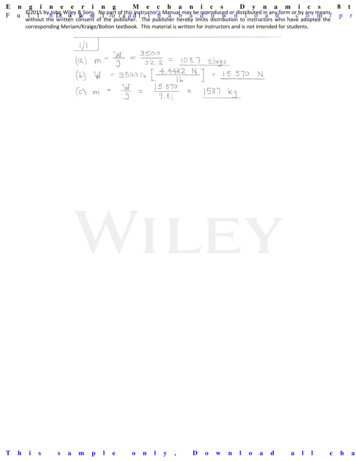

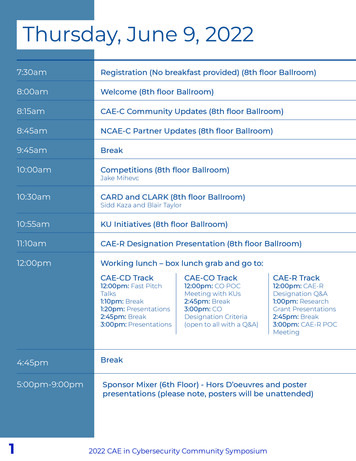

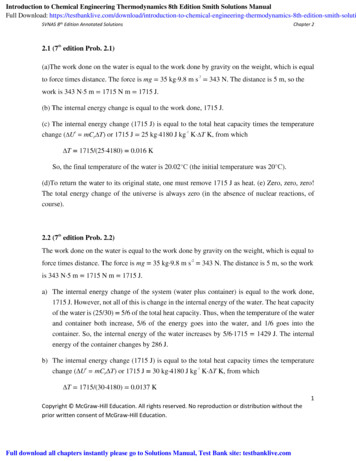
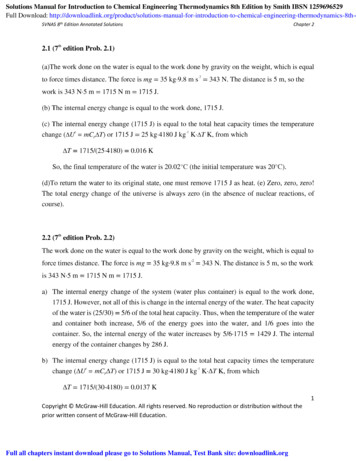

![Welcome [ieaninepoints ]](/img/16/2007-iea-global-conference-program.jpg)
